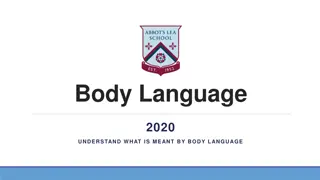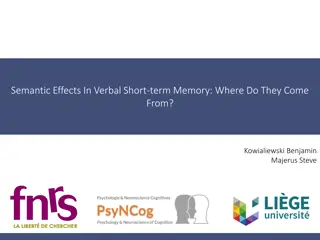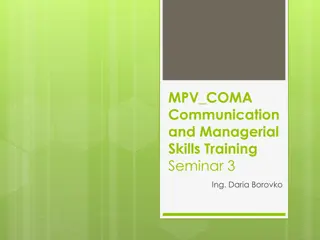
Understanding National Core Indicators (NCI): Profiles and Participation
Explore the National Core Indicators program, a multi-state collaboration assessing performance in various areas for individuals with intellectual and developmental disabilities. Discover data sources, methods, and the distinction between verbal and non-verbal respondents. Dive into state participation and key insights from standardized surveys.
Download Presentation

Please find below an Image/Link to download the presentation.
The content on the website is provided AS IS for your information and personal use only. It may not be sold, licensed, or shared on other websites without obtaining consent from the author. If you encounter any issues during the download, it is possible that the publisher has removed the file from their server.
You are allowed to download the files provided on this website for personal or commercial use, subject to the condition that they are used lawfully. All files are the property of their respective owners.
The content on the website is provided AS IS for your information and personal use only. It may not be sold, licensed, or shared on other websites without obtaining consent from the author.
E N D
Presentation Transcript
NCI Survey Respondents Who Are Verbal and Non-Verbal: A Profile
WHAT IS NATIONAL CORE INDICATORS (NCI)? Multi-state collaboration of state DD agencies Measures performance of public systems for people with intellectual and developmental disabilities Assesses performance in several areas, including: employment, community inclusion, choice, rights, and health and safety Launched in 1997 in 13 participating states NASDDDS HSRI Collaboration National Core Indicators (NCI)
NCI State Participation 2013-14 ME NH WA MA MN OR NY WI SD MI PA NJ OH* DE MD IN IL UT VA Wash DC CO CA* KS KY MO NC TN OK SC AR AZ NM GA AL MS 39 states, the District of Columbia and 22 sub-state regions LA TX FL HI State contract awarded in 2013-14 through AIDD funding CA*- Includes 21 Regional Centers OH*- Also includes the Mid-East Ohio Regional Council
Data Source: Adult Consumer Survey Standardized, face-to-face interview with a sample of individuals receiving services Background Information Section I (no proxies allowed) Section II (proxies allowed) No pre-screening procedures Conducted with adults only (18 and over) receiving at least one service in addition to case management Section I and Section II together take 50 minutes (on average) National Core Indicators (NCI)
Verbal vs. Non Verbal Respondents- Adult Consumer Survey
Methods, Measures and Sample: 2011-2012 data collection cycle 19 states, one regional council (AL, AR, AZ, CT, GA, HI, IL, KY, LA, MA, ME, MI, MO, NC, NJ, NY, OH, PA, SC and the Mid- East Ohio Regional Council) Total N: 12,236 individuals National Core Indicators (NCI)
Methods, Measures and Sample: Verbal vs. Non-Verbal Source: Item from Background Section What is this person s primary means of expression? Spoken Gestures/body language Sign language or finger spelling Communication aid/device Other Don t know Recoded to create Verbal/Non-Verbal variable National Core Indicators (NCI)
Demographic Profile Non-Verbal 23.9% Verbal 76.1% National Core Indicators (NCI)
Demographics Average Age: Years Gender: Male 100 100% 90 90% 80 80% 70 70% 58.0% 60 55.6% 60% 50 50% 43.6 43.4 40 40% 30 30% 20 20% 10 10% 0 0% Non-Verbal Verbal Non-Verbal Verbal National Core Indicators (NCI)
Demographics: Race and Ethnicity (p<.001) 5.6%Non-Verbal Verbal 4.3% 22.0 % White, Non- Hispanic Black, Non- Hispanic Hispanic White, Non- Hispanic Black, Non- Hispanic Hispanic 19.2% 72.4 % 76.4% Entire NCI Sample 4.7% White, Non- Hispanic 19.9% Black, Non- Hispanic 75.5% Hispanic National Core Indicators (NCI)
Demographics: Other Diagnoses 100% Non-Verbal Verbal 90% 80% 70% 60% 50% 40.3% 37.7% 40% 25.4% 30% 20.5% 20.1% 17.7% 10.6% 20% 13.0% 11.0% 10.1% 9.5% 8.3% 5.1% 10% 3.8% 0% Mental Illness/ Psychiatric Diagnosis*** Autism Spectrum Disorder*** Cerebral Palsy*** Seizure Disorder/ Neurological Problem*** Limited or No Vision/ Legally Blind*** Hearing Loss- Severe or Profound*** Down Syndrome** *** (p<.001) ** (p<.01) National Core Indicators (NCI)
Demographics Mobility (p<.001) Guardianship Status (p<.001) 100% 100% Non-Verbal Verbal Non-Verbal Verbal 90% 90% 83.3% 80% 80% 70% 70% 58.5% 56.8% 60% 60% 54.7% 50% 50% 37.3% 40% 33.9% 40% 30% 28.0% 30% 20% 17.4% 7.6% 20% 5.9% 13.2% 10% 10% 3.5% 0% Person is independent of guardianship Limited guardianship Full 0% guardianship Moves self around environment without aids Moves self around environment with aids or uses wheelchair independently Non-ambulatory, always needs assistance National Core Indicators (NCI)
Demographics Health (p<.001) 100% Non-Verbal 90% Verbal 80% 70% 61.8% 60% 53.6% 50% 42.3% 40% 31.3% 30% 20% 6.8% 10% 4.1% 0% Excellent or very good Fairly good Poor National Core Indicators (NCI)
At least one kind of medication for mood disorders, anxiety, behavior problems or psychotic disorders (p<.001) PreventiveCare 100% 100% 93.3% 90.2% Non-Verbal 90% 90% Verbal 80% 80% 70% 70% 61.8% 58.9% 60% 60% 55.4% 50% 47.8% 50% 40% 40% 30% 30% 20% 20% 10% 10% 0% Phys. Exam in Past Year*** Vision Exam in Past Year** 0% Non-Verbal Verbal *** p<.001 ** p<.01 National Core Indicators (NCI)
Residence Type (p<.001) 100% Non-Verbal Verbal 90% 80% 70% 60% 50% 41.9% 37.2% 40% 34.6% 30.8% 30% 20% 15.2% 12.2% 6.0% 6.3% 10% 4.9% 4.8% 4.1% 2.2% 0% Institution Community-based residence Independent home/apt Parents/relatives home Foster care/host home Other National Core Indicators (NCI)
Employment In the past 2 weeks, was person engaged in . 70% Non-Verbal Verbal 59.3% 60% 50% 45.7% 40% 32.0% 30% 22.2% 17.9% 20% 16.7% 10.5% 10% 1.9% 0% Paid Community Job*** Unpaid Community Activity*** Paid Facility-based Work*** Unpaid Facility-based Activity*** ***p<.001 National Core Indicators (NCI)
Employment Of the individuals who do not have a job, the following would like a job (p<.001) Do you go to a day program or other activity during the day? (p<.001) 100% 100% 90% 90% 84.3% 80% 80% 72.8% 70% 70% 60% 60% 47.2% 50% 50% 40% 40% 28.4% 30% 30% 20% 20% 10% 10% 0% 0% Non-Verbal Verbal Non-Verbal Verbal National Core Indicators (NCI)
Services Received 100% 94.1% 91.7% Non-Verbal Verbal 90% 80% 64.9% 70% 61.3% 60% 50.6% 50% 38.8% 40% 28.2% 30% 24.2% 19.9% 20% 9.2% 10% 0% Service Assistive Technology*** Clinical Services*** Transportation *** Respite or Family Support*** Coordination or Case Management*** *** p<.001 ** p<.01 National Core Indicators (NCI)
Home 100% 95.0% 92.9% Non-Verbal Verbal 87.8% 89.7% 90% 80% 70% 60% 50% 36.9% 40% 27.5% 26.7% 30% 19.8% 20% 10% 0% Do you like where you live?*** Would you like to live somewhere else?*** Do you like your neighborhood?** Do you ever talk to your neighbors?*** *** p<.001 ** p<.01 National Core Indicators (NCI)
Safety 50% Non-Verbal Verbal 45% 40% 35% 30% 25% 20% 13.8% 15% 10.3% 8.3% 7.5% 10% 5.3% 4.5% 4.4% 3.7% 5% 0% Afraid at home most of the time*** Afraid in Afraid at work/day program most of the time*** If you ever feel afraid, there isn't anyone you can go to for help*** neighborhood most of the time** *** p<.001 ** p<.01 National Core Indicators (NCI)
Relationships 100% Non-Verbal Verbal 90% 76.3% 80% 71.7% 70% 65.5% 64.6% 60% 54.7% 49.7% 50% 40% 30% 20% 10% 0% Has friends who are not staff or family*** *** p<.001 ** p<.01 Has a best friend*** Can go on a date without restrictions*** National Core Indicators (NCI)
Community Participation I 100% Non-Verbal Verbal 90.9% 87.0% 85.9% 90% 80.6% 76.6% 80% 73.4% 73.2% 67.7% 70% 60% 50% 40% 30% 20% 10% 0% Went shopping in the past month*** Went out on errands in the past month*** Went out to entertainment in the past month*** Went out to eat in the past month*** *** p<.001 ** p<.01 National Core Indicators (NCI)
Community Participation II 70% Non-Verbal Verbal 58.6% 60% 51.2% 50.5% 48.0% 50% 39.6% 40% 34.8% 30% 20% 10% 0% Went to religious services in the past month*** *** p<.001 ** p<.01 Participated in sports in the past month*** Went on vacation in the past year*** National Core Indicators (NCI)
Choice I Person had at least some input in .. 100% 94.5% 87.0% 90% Non-Verbal Verbal 76.1% 80% 70% 63.4% 59.7% 56.7% 60% 50% 44.3% 43.3% 40% 30% 21.3% 17.2% 20% 10% 0% Choosing home*** Choosing roommates*** Choosing home staff*** Choosing daily schedule*** Choosing what to do in freetime*** ***p<.001 National Core Indicators (NCI)
Choice II Person had at least some input in .. 100% 94.1% Non-Verbal Verbal 90% 80% 66.9% 70% 64.9% 60.9% 58.0% 60% 46.9% 46.5% 50% 40% 33.9% 30% 20% 10% 0% Choosing day activity*** Choosing day activity staff*** Choosing what to buy*** Choosing case manager*** ***p<.001 National Core Indicators (NCI)
Rights and Respect 100% 91.5% Non-Verbal 86.8% 90% 81.4% Verbal 80% 74.4% 70% 60% 50% 40% 27.9% 30% 19.4% 16.6% 20% 11.8% 10% 0% Mail is read without permission*** Can be alone with guests*** Can use phone or internet without restrictions*** Has partcipated in a self advocacy activity*** ***p<.001 National Core Indicators (NCI)
Additional Services Needed I 40% Non-Verbal Verbal 34.5% 35% 31.7% 30% 25% 22.9% 21.2% 20.7% 20% 14.6% 15% 9.0% 10% 7.3% 5% 0% Finding or changing jobs*** Education or training*** Finding or changing housing*** Social/relationship*** ***p<.001 National Core Indicators (NCI)
Additional Services Needed II 40% 37.3% Non-Verbal 35% Verbal 30% 27.2% 27.1% 25% 21.9% 20% 15% 9.7% 8.2% 10% 5% 0% Communication technology*** Environmental adaptations/ home modifications*** Other*** ***p<.001 National Core Indicators (NCI)
Conclusions- Individuals who are non- verbal are: Less likely to have a paid job in the community, and less likely to be doing any activities during the day More likely to be scared in several environments (home, neighborhood and day activity) and less likely to have someone to talk to about being scared Less likely to have relationships and be involved in the community Less likely to make choices and decisions More likely to not have their rights respected National Core Indicators (NCI)
Future Research.. It is important to continue this research and control analyses for demographic and personal characteristics that may influence outcomes. More detailed knowledge about the non- verbal population can lead to more targeted policies National Core Indicators (NCI)
Contacts HSRI Josh Engler: jengler@hsri.org NASDDDS Mary Lee Fay: MLFay@nasddds.org NCI website: www.nationalcoreindicators.org National Core Indicators (NCI)






















